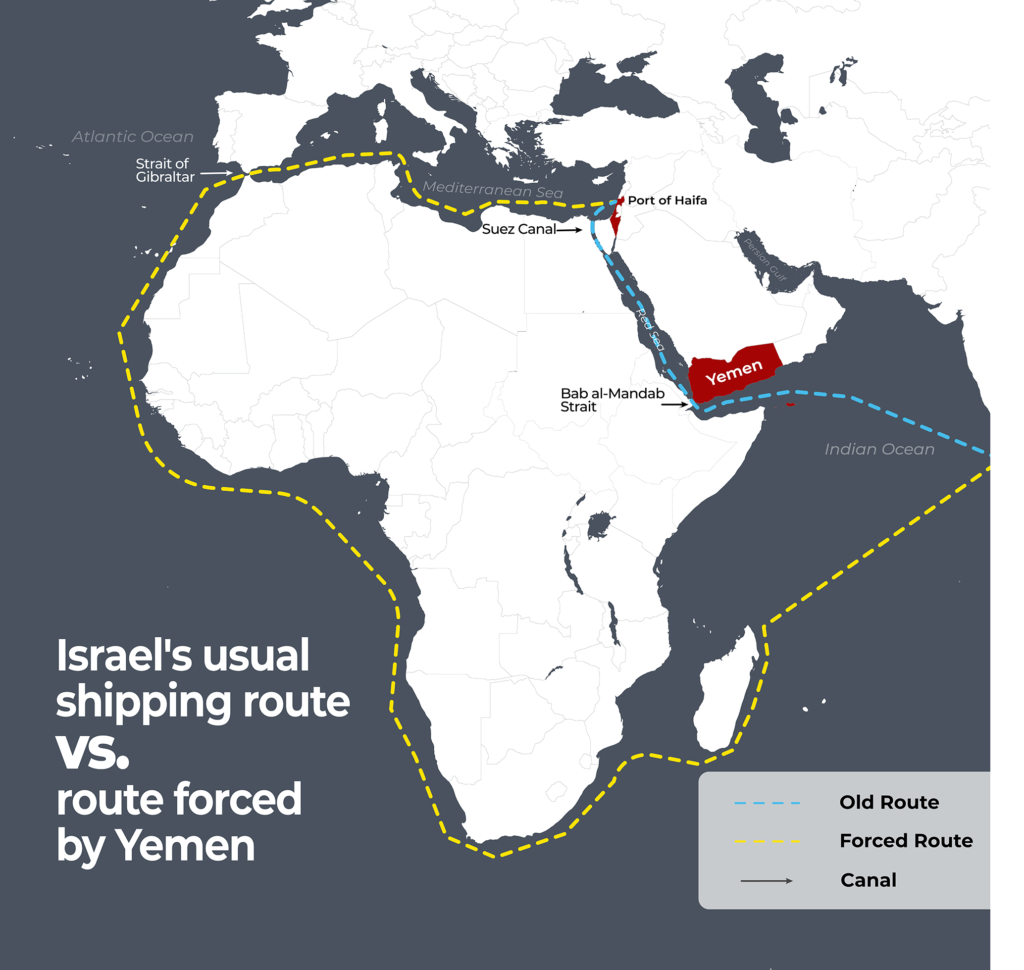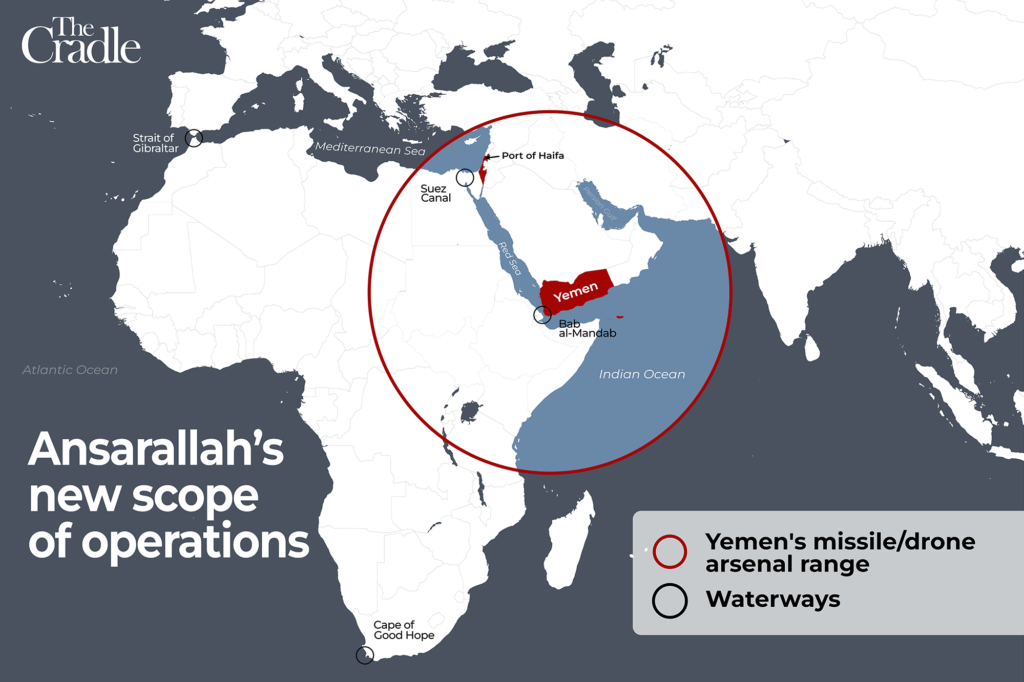Ansarallah’s maritime operations against Israeli-linked shipping just expanded into the Mediterranean Sea, the Eurasian waterway NATO has long considered its own domain, home to Israel’s oil and gas platforms, and the site of Washington’s new ‘aid pier’ ploy.
In support of Gaza, Yemen’s Ansarallah-aligned armed forces executed their first direct operation against Israel on 18 October 2023. That operation involved cruise missiles and drones targeting the port of Eilat in southern occupied Palestine and came less than two weeks after the Palestinian resistance’s Operation Al-Aqsa Flood flipped the script in West Asia.
Similar attacks ensued in rapid fire, with further warnings from the Yemeni military that it would “continue to carry out qualitative strikes with missiles and drones until the Israeli aggression stops.” One month later, amidst Tel Aviv’s worsening carnage in Gaza, Sanaa commenced its targeting of Israeli-linked and destined shipping vessels in the Red Sea, effectively blocking their passage through the Bab al-Mandab Strait.
‘Phased’ maritime operations
This marked Yemen’s first phase of a meticulously planned series of naval operations. The second phase saw a broader prohibition, blocking ships from any country from approaching Israeli ports – a waterway siege, just as Yemen has endured for eight long years. Sanaa’s scope of operations then broadened in the third phase to include the Indian Ocean, targeting Israeli vessels navigating the much longer Cape of
Good Hope route – around the African continent – to deliver goods to the occupation state.

As tensions escalated, and to protect Israel, US and British naval forces cobbled together a ramshackle coalition of non-Arab states, Operation Prosperity Guardian, to strike Yemen – a country already ravaged by almost a decade of US-backed Saudi–UAE bombardment and siege.
This provoked a forceful and immediate response from Yemeni forces, who extended their target range to include US and British naval assets and, later, to expand their operational theater to the vast Indian Ocean.
But as Israel’s threats to invade and bombard Rafah intensified in recent days, Sanaa announced the start of a fourth phase of escalation, a significant ramp-up in their military response.
This phase will target Israeli ships or those heading to Israeli ports in the Mediterranean Sea and impose comprehensive sanctions on all vessels linked to companies that frequent the occupied state’s ports. Furthermore, the measures will be applied to all shipping vessels and companies that deliver goods to Israel, regardless of their final destinations. This effectively bars them from all Yemeni operational waterways.
The declaration of this fourth phase is a clear signal of widening the conflict zone to include the Mediterranean and tightening the siege on Israel, which economically depends on sea trade. It poses a renewed challenge to Tel Aviv and its allies, increasing pressure, particularly on Washington and its European partners.

Advancement of military capabilities
Sanaa’s strategic move is timed with ongoing ceasefire negotiations involving Hamas, which faces intense pressure to accept terms favorable to Israel, and is part of a broader strategy to influence political outcomes far beyond Yemen’s borders.
The Yemeni “circle of fire” – its maritime reach – now encompasses the Red Sea, the Arabian Sea, the Gulf of Aden, the Indian Ocean, and the Mediterranean Sea. On land, Sanaa’s focus is on impacting Israel’s geographic depth, particularly its southern regions which abut the Red Sea.
In multiple speeches, Ansarallah leader Abdul Malik al-Houthi has emphasized Yemen’s staggering advances in military capabilities, both quantitatively and qualitatively. These advancements are made possible by various factors, most notably the real-world testing of their arsenal.
Recent broadcasts showcased a distant suicide drone targeting a ship in the Red Sea, equipped with a camera on its nose. Additionally, there has been significant Yemeni progress in the use of winged and ballistic missiles: according to military analysts, for the first time in history, anti-ship ballistic missiles were deployed against seaborne vessels, a qualitative advancement in Ansarallah’s military bag of tricks.
Sanaa’s strategic rise
Speaking to The Cradle, Brigadier General Mujib Shamsan, Chairman of the Yemeni Military Spokesmen’s Committee for the Media, says that Sanaa benefited from its operations and confrontation with American and British forces to fast-track its capabilities.
This is clearly evident through the comparison between the operations it carried out at the beginning of its decisions up to the end. Operations in the Gulf of Aden, the Arabian Sea, and the Indian Ocean, where it was able to accumulate and develop its capabilities continuously, whether at the level of missile force, unmanned air force, or other naval weapons, thus bypassing various American defense systems, learning many tactics regarding confronting them, and even bringing it to a state of failure.
The failings of the two western coalitions dedicated to thwarting Yemen’s siege of Israel have become apparent to all.
Since early April, various European naval commanders have thrown their hands up in full public view.
Jerome Henry, commander of France’s Aquitaine-class FREMM frigate Alsace – deployed in the Red Sea for 71 straight days – said on 11 April that his ship had depleted its entire combat arsenal, and while it would head to port to replenish those munitions, would return to face an impossible mission:
We didn’t necessarily expect this level of threat. There was an uninhibited violence that was quite surprising and very significant. [The Yemenis] do not hesitate to use drones that fly at water level, to explode them on commercial ships, and to fire ballistic missiles.
“We had to carry out at least half a dozen assistances following [Yemeni] strikes,” Henry told French publication Le Figaro.
Also in early April, Rear Admiral Vasileios Gryparis, the Greek commander of the EU’s Operation Aspides, warned that his mission would not succeed with only three warships available to protect shipments through the Bab al-Mandab Strait. Since “the launch of the Operation Aspides on 19 February 2024 until now, the threat level remains the same,” lamented Gryparis.
Yemeni Brigadier-General Shamsan points out that the US defense system failures, and growing risks faced by the anti-Yemen naval coalitions, have “forced it and its allies to withdraw more than 18 ships from the theater of operations, as the number of American ships that left reached 10, while eight ships belonging to European tools left.”
Shamsan says the rapid development of Sanaa’s military capabilities during the ongoing war has positioned Yemen as a pivotal player not only regionally but globally, owing to its strategic position overseeing one of the world’s most crucial maritime passages.
As Ansarallah’s phase four operations commence in the Mediterranean Sea, Shamsan declares that Yemen has now effectively implemented a maritime blockade and economic stranglehold on Israel, which heavily relies on sea routes for the vast majority of its imports.
This blockade, in turn, represents a significant leverage point against both Tel Aviv and its western allies, which have failed to protect their interests in the Red Sea or counteract Sanaa’s embargo on ships entering the ports of the occupation state.
Far from being a mere political and military backwater, Yemen has demonstrated far-reaching military capabilities and impressive strategic planning that has confounded the world’s greatest naval powers. Sanaa’s formidable maneuvers in West Asian maritime zones have catapulted it to the forefront of the region’s Axis of Resistance as the member most capable of influencing global maritime security and regional stability.
As the US and its allies rally around their newly constructed “aid pier” on Gaza’s Mediterranean coastline to, as many suspect, consolidate the area as a future site for US military operations and protect Israel’s oil and gas platforms, Yemen is emerging as a frontline adversary in that far-flung theater.
 Eurasia Press & News
Eurasia Press & News




